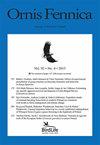Spatial ecology of the Red Kite (Milvus milvus) during the breeding period in Spain
IF 1.2
4区 生物学
Q2 ORNITHOLOGY
引用次数: 1
Abstract
Studies focusing on the spatial ecology of the Red Kite (Milvus milvus) during the breeding season are scarce, despite this season having major importance in its conservation. Spain has one of the largest breeding populations of this species, but it is very threatened in this country. Here, 28 Red Kites were tagged in Spain with GPS satellite transmitters to study the movements of breeding adults during the breeding season (March-June), evaluating the differences according to sex, and investigating the habitat selection. The area used by females was smaller than the used by males (95% KDE = 4.48 vs. 3.30 km2). Females also traveled less distance per hour and remained closer to the nest. Thus, females had a higher frequency of locations at distances <250 m from the nest, while males had a higher frequency at distances >1 km. Distances recorded at >5 km were scarce for both sexes, and maximum distances reached were usually (61% of seasons) less than 15 km. Both sexes increased the frequency of movements between 1–3 km during the central hours of the day. Red Kites mainly used areas occupied by non-irrigated arable land, forests, scrubs, and herbaceous vegetation. The selection of certain types of crops highlights the importance of the agroforestry landscape for the conservation of the species. On the other hand, we documented for the first time how part of the Spanish breeding population is a short-distance migrant within the Iberian Peninsula while other part of the population makes post-breeding movements during summer.西班牙红鸢(Milvus Milvus)繁殖期的空间生态
红鸢(Milvus Milvus)在繁殖季节的空间生态学研究很少,尽管繁殖季节对其保护具有重要意义。西班牙是该物种繁殖数量最多的国家之一,但它在这个国家受到严重威胁。在西班牙,用GPS卫星发射机对28只红鸢进行了标记,研究了在繁殖季节(3 - 6月)繁殖成虫的活动,评估了性别差异,并调查了栖息地选择。女性使用的面积小于男性使用的面积(95% KDE = 4.48 vs. 3.30 km2)。雌性每小时移动的距离也更短,并且离巢穴更近。因此,雌性在距离1公里的地方有更高的频率。在50 ~ 5公里的距离记录对两性来说都很稀少,最大距离通常(61%的季节)小于15公里。在一天的中心时段,男女的运动频率都增加了1-3公里。红风筝主要用于非灌溉耕地、森林、灌木丛和草本植被。某些作物类型的选择突出了农林复合景观对物种保护的重要性。另一方面,我们首次记录了西班牙繁殖种群的一部分是在伊比利亚半岛内的短途迁徙,而另一部分种群在夏季进行繁殖后的迁徙。
本文章由计算机程序翻译,如有差异,请以英文原文为准。
求助全文
约1分钟内获得全文
求助全文
来源期刊

Ornis Fennica
生物-鸟类学
CiteScore
2.00
自引率
0.00%
发文量
14
审稿时长
>12 weeks
期刊介绍:
Ornis Fennica is a peer-reviewed international ornithological journal published by BirdLife Finland. Ornis Fennica publishes analytical and experimental papers on the ecology, behaviour and biogeography of birds. Ornis Fennica prefers studies concerning Fennoscandian species, but other novel contributions of general interest are most welcome as well.
Ornis Fennica is an open-access journal without page charges for publication. All published articles (from 1924 onwards) are freely available from the journal website. First decisions are usually made within three months of submission.
 求助内容:
求助内容: 应助结果提醒方式:
应助结果提醒方式:


